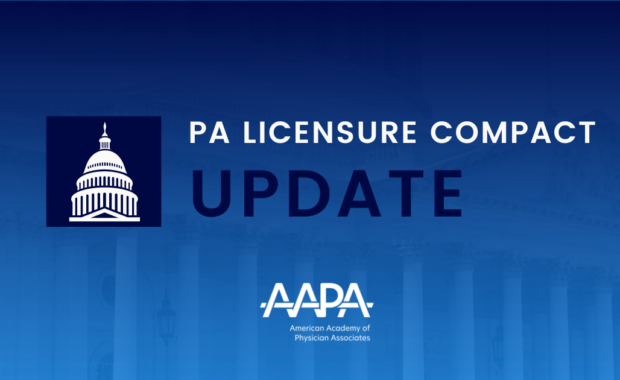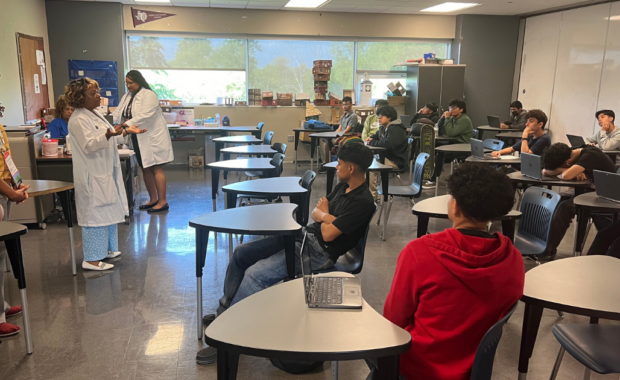Strategies to Manage Cognitive Load in PA School
PA Educator Shares the Science Behind Cognition
September 29, 2020
By Kristopher R. Maday, MS, PA-C, DFAAPA

This is the second part of a series from PA educator Kristopher Maday. Find out how to enhance your study strategy to maximize learning in part one of this series.
You know now that there is a complex interaction between the sensory stimuli that learners are bombarded with during PA school (working memory) and the cognitive processes to code and file information away for retrieval when they are taking tests or caring for patients (long-term memory). The majority of the studying process is done in working memory, as this is the “memory playground” where we make associations and rehearse information for easy storage in long-term memory. In order to be recalled efficiently and correctly, information must make its way from your working memory to your long-term memory.
[AAPA Student Members: Access Your Exclusive Picmonic Benefit]
The problem lies in the fact that working memory is analogous to working online: all the information is right in front of you (sensory stimuli) but it is taking up very little storage space. Your working memory just doesn’t have a large capacity. You could save every single website or page you find individually to your desktop, but it will soon overload your computer (or cognitive system), as you will have to go through every single page each time you need to find something. This is not very efficient and it soon becomes overwhelming. So what do you do? You start putting these pages into folders so you can organize them to find them more easily the next time you need to look for something. These are called schemas, which are organizational strategies that incorporate large amounts of information into smaller storage elements. The most well-known example of schemas are mnemonics. By using schemas and organizing the information you receive from your working memory, you are encoding information into your long-term memory storage. The problem is you can only do so many of these tasks at one time. This is what cognitive psychologists call “cognitive load.” The more complex a task is or the higher amount of new information being presented, the more cognitive load is placed on working memory. The higher the cognitive load, the higher likelihood you will experience information overload.
[Study Less, Remember More: A PA Student Webinar]
What is cognitive load?
The textbook definition of cognitive load is the total amount of mental activity imposed on working memory at any one instant. This can be broken down into two distinct factors:
1) The volume of information
2) The complexity of the tasks
We have all experienced cognitive load firsthand. Think about when you drive home from work or school. You take the same roads and make the same turns day in and day out. You can even talk with somebody on the phone, or get lost in thought, and still get from point A to point B. Now, think about being in a new city or having to take a new route home due to traffic. All of the sudden, you can’t have any distractions because you need all your mental energy to process this new information. This is cognitive load and it can overload your working memory very quickly and easily.
There are three main types of cognitive load and each is unique in how it is applied to learning. Germane cognitive load is the energy required to develop new schemas and organizational strategies. This is regarded as the “good” cognitive load, as it is needed to process the information in working memory into easily remembered schemas for more efficient recall. Intrinsic cognitive load is the necessary energy needed to learn the task or information being processed. Complex tasks or large volumes of information still need to be processed and this amount of cognitive load does not change and is deemed “necessary” in the learning process. Extraneous cognitive load is the “bad” type and makes up the mental activities that are detrimental to learning by actually interfering with the construction and organization of new schemas. I mentioned in my previous post that reading a slide full of text is not teaching because it places an increased amount of extraneous cognitive load on students and inhibits the processing of information and construction of schema.
[Read: Surviving Your Didactic Phase]

Ways students and professors can effect cognitive load
There are many ways students and faculty can increase the germane cognitive load while decreasing the extraneous cognitive load to improve learning and retention. Trying to study each individual disease or condition places a huge intrinsic cognitive load on the learner. Instead, students can start grouping diseases into schemas of similar presenting signs and symptoms (something we like to call a differential diagnosis) to facilitate recall during patient interviewing. Students can also study different sections together that are related, such as reading over physiology of a disease process while learning the pharmacologic management. Now, instead of memorizing the medications for a disease treatment, the student will start to understand why the medication is given in the first place.
Some medical schools and PA programs have adopted this strategy of block instruction, where students are taught anatomy, physiology, pathology, history and physical exam, pharmacology, and clinical medicine for a subsystem (cardiovascular, pulmonary, dermatologic, etc.) over a several week block. One of the benefits of this strategy is that the approach facilitates the construction of schemas by teaching the material in concentrated sections. Faculty can decrease extraneous cognitive load in their teaching by limiting competing information and not overwhelming the sensory input, helping automate already developed schemas by using spaced repetition, and reintroducing key concepts from the lecture or previously taught material.
By understanding how information is processed in working memory and the cognitive load that is required, PA students (and faculty) can develop effective strategies to increase educational efficiency, improve retention and recall, and help ease the already stressful process of learning medicine.
References
- What is cognitive load? The eLearning Coach. Available at: http://theelearningcoach.com/learning/what-is-cognitive-load/. Accessed February 8, 2016.
- Schnotz W, Kurschner C. A Reconsideration of Cognitive Load Theory. Educ Psychol Rev (2007) 19:469–508.
- Bruce Goldstein. Cognitive Psychology: Connecting Mind, Research and Everyday Experience. Wadsworth Publishing, 2010
- Debue N, van de Leemput, C. What does germane load mean? An empirical contribution to the cognitive load theory. Frontiers in Psychology. 2014;5(1099):1-12.
Kristopher R. Maday, MS, PA-C, DFAAPA is Associate Professor and Program Director in the PA Program at the University of Tennessee Health Science Center in Memphis, Tennessee. Contact him at [email protected]. Follow him on Twitter @PA_Maday.
You May Also Like
PA Students: Enhance Your Study Strategy to Maximize Learning
How to Stay on Track in PA School During a Global Pandemic
The Ups and Downs of My First Year as a PA
Thank you for reading AAPA’s News Central
You have 2 articles left this month. Create a free account to read more stories, or become a member for more access to exclusive benefits! Already have an account? Log in.



